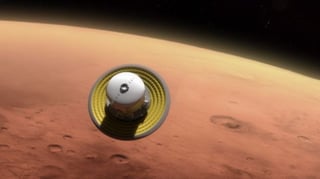Could the entry of Mars with balloons work by inflating to equalize with the atmospheric air pressure, while establishing buoyancy before meeting the ground?
Would a balloon pop if dropped from space?
As this article writes,
“Ballutes” – a cross between balloons and parachutes – may one day act as lightweight heat shields and braking mechanisms for cargo or even people landing on the Earth or Mars from space. The concept recently received a boost from NASA, which is funding a proposal to develop the idea.
Most spacecraft use solid heat shields to protect themselves when they slam into the atmosphere from space. Those used for a single landing have “ablative” heat shields that gradually erode in the atmosphere, while the space shuttle, which is used over and over again, boasts a reusable heat shield.
Blimp on Earth, but a glider on Mars?
How high could a weather balloon be used on Mars without rupturing?
When the blimp achieves terminal velocity, the heat shield is dropped to increase buoyancy.

